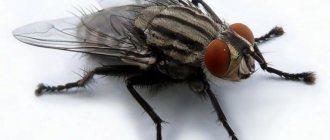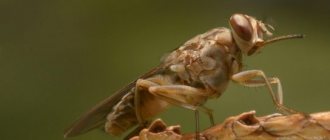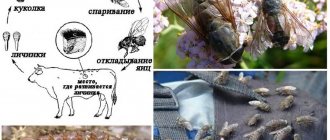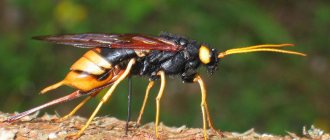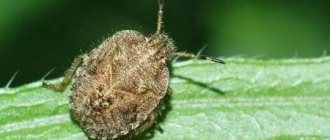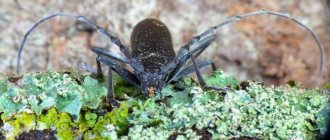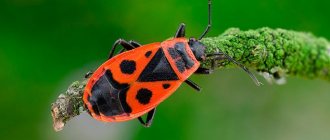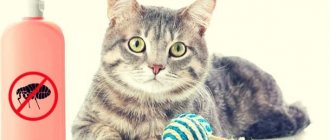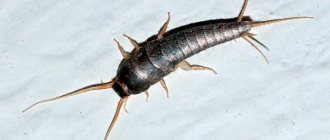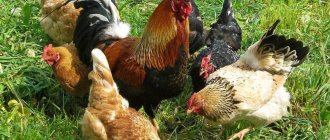- Wild animals
- >>
- Insects
There are a huge number of different insects in the world. One of the most famous and widespread is the Drosophila fly . These tiny flies are familiar to absolutely everyone. You don’t have to wait long for their appearance if there is a bitten or slightly rotten fruit in the house. Even a few days are enough for a whole swarm of fruit flies to appear over a half-eaten peach or apple.
Origin of the species and description
Photo: Drosophila fly
The Drosophila fly can appear in any home, and in vegetable or fruit warehouses and stores it is a permanent resident. This animal is familiar to any gardener and gardener. This fly is quite annoying and extremely difficult to get rid of. Despite this, fruit flies are highly valued by scientists. They are unique scientific material. Today various experiments and scientific experiments are carried out on this animal.
Video: Drosophila fly
The Drosophila fly is called differently: Drosophila minor, fruit fly, fruit midge, Drosophila vulgaris. In Latin the name sounds like Drosophila melanogaster. This is an insect with two wings, a type of midge belonging to the genus Drosophila. Drosophila belongs to a large family of fruit flies.
Interesting fact: Drosophila has many different names and nicknames. People call these insects wine or vinegar flies. This is due to the fact that they very quickly detect the source of the sour fruity smell. Therefore, there are many such animals in various factories and plants for the production of juices and wine.
Today there are quite a few varieties of fruit flies. Scientists count more than a thousand species. Most species live in subtropical and tropical climates. In particular, more than three hundred species of such insects live on the Hawaiian Islands alone. On the territory of the Russian Federation, the most common type of fly is the flightless Drosophila.
The Drosophila fly is characterized by the following features:
- a diet consisting of fermented products;
- high sensitivity to sour aromas;
- fertility - one female is capable of laying several hundred eggs throughout her life;
- the presence of obvious visual differences between females and males.
Fly in the house: how to get rid of it using traps
Trap with bait for fruit flies
Destruction of fruit flies is a rather labor-intensive process. In order not to take up the newspaper and kill flies manually, you can make traps from improvised materials or buy ready-made ones.
Types of traps for small insects:
- Place a few pieces of banana or apple in a glass jar and pour in sweet syrup or juice. Make a funnel from a sheet of paper so that there is a small hole at the bottom. Place the funnel in the container with the tip down and seal the diameter with tape on the neck at the joint. Fruit flies will fly to the smell of the bait, get trapped and will no longer be able to get out.
- Pour apple cider vinegar into a deep plate, add a little water and a couple of drops of dishwashing detergent. Cover the container with cling film and make several holes in it with a thick needle or toothpick. The flies will fly into the trap, they will be attracted by the smell of the bait, and will no longer be able to get out of it.
- You can remove small flies from your home using a glue trap with Raptor liquid bait. Insects are attracted to the substance with which its inner side is treated. Once they land on a sticky surface, they can't get back out. Drosophila remain inside the trap, thereby maintaining its aesthetic appearance.
Appearance and features
Photo: What a Drosophila fly looks like
The Drosophila fly is called a fruit fly because of its special relationship with vegetable and fruit waste. It is quite easy to recognize this insect.
It has certain characteristic external features:
- small sizes. This is a tiny midge. The average length of an insect is about two millimeters. In this case, the wings are always longer than the body. Female representatives are slightly larger. Their average length is two and a half millimeters;
- bright and prominent eyes. Drosophila has bulging, red eyes. They consist of a large number of segments. Of course, it is problematic for a person to see them with the naked eye. This feature of this tiny insect can only be seen if it is greatly enlarged;
- brown-yellow body color. The color of different species may vary slightly - be lighter or darker;
- bristles with pointed ends. This feature is characteristic of male flies;
- round or cylindrical abdomen. A cylindrical abdomen is characteristic of males, and a more rounded abdomen is characteristic of females;
- eight well-developed tergites in females. Males have only six of them, because two tergites are fused together;
- the presence of durable chitinous plates. Despite their small size, these insects have a durable chitinous coating in the form of plates. Females have a larger number of such plates, while in male Drosophila the four platinas are not developed.
The appearance of fruit flies depends not only on nature. It may vary depending on the climate, environmental characteristics and nutrition of the animal. It is also worth remembering that these insects are great travelers. They very often travel from one country to another on fruits and vegetables. In this case, the midges may slightly change their color and habits.
Prevention measures
To prevent Drosophila flies from appearing in your home, the following conditions must be observed:
- If fruits and vegetables can be stored in the refrigerator, then keep them in the fresh zone to kill fruit fly eggs;
- wash fruits and vegetables with cold water immediately before eating;
- do not leave fruits unharvested;
- promptly separate rotten fruits and vegetables from fresh ones;
- throw away garbage in a timely manner so that the rotting process does not begin;
- Install protective insect nets on windows in the warm season - get rid of flies, flies, and mosquitoes.
Where does the Drosophila fly live?
Photo: Drosophila fly in Russia
The Drosophila fly requires certain conditions to exist and reproduce. This insect needs a warm climate. It does not live in countries with very cold winters and cool summers. Such midges need warmth, so they feel ideal in the tropics and subtropics. Drosophila flies are widespread in areas where the air temperature does not drop below ten degrees Celsius every day.
To live outdoors, the Drosophila fly requires an air temperature of plus sixteen degrees. At a temperature of eighteen degrees, this insect can live for about a month. If the temperature is much higher (above 25 degrees), then life expectancy is reduced. However, in this climate, fruit flies multiply quickly. Also, the number of such animals increases sharply at high humidity. For this reason, tropical islands where it rains frequently have the highest populations of fruit flies.
Fun fact: Drosophila flies are tiny, but very hardy. They can exist in difficult environmental conditions. For this reason, they have always been and are now valuable objects of biological research. These animals have even been on space stations and ships.
This type of fruit fly is widespread throughout the world. The Drosophila fly is found everywhere where vegetables and fruits grow, and it gets into other regions along with imported products. It lives in large numbers in the south of Russia. More than three hundred species of such flies live in the Hawaiian Islands. Only northern countries, where abnormally low temperatures persist throughout the year, can be excluded from their natural habitat.
Interesting Facts
Drosophila is the most valuable organism for biological research, especially for genetics. The fly has been used as a model organism for various types of research for a century now.
The use of Drosophila for experimental research is due to its small size and short life cycle. In addition, it is an inexpensive individual for the processes of reproduction and breeding of even a huge number of insects. They are excellent for cultivation in laboratory conditions.
Mutants of individuals with any gene defects are available for a variety of experiments.
What does the Drosophila fly eat?
Photo: Male Drosophila fly
Fruit flies, as noted earlier, are permanent inhabitants of places where vegetables and fruits are stored. They are present in large quantities in large warehouses, vegetable stores, shops, and markets. And from these places they end up in residential buildings, restaurants and apartments. Drosophila flies find their food in these places.
The vinegar fly, which is no more than three millimeters long, has an excellent appetite. It feeds on plant sap, plant debris, and rotting parts of fruits. During the larval stage, Drosophila also consume various microorganisms. The diet of adult fruit flies includes: onions, potatoes, apples, nuts, cherries, grapes, pumpkins, cereals, jams, preserves, fruit compotes, and much more.
These products serve not only as food, but also as a breeding ground. In the presence of a suitable temperature regime and the appearance of fermentation products, Drosophila flies begin to actively reproduce. It is extremely difficult to combat such insects, especially in large warehouses, where it is difficult to find and eliminate all spoiled fruits and vegetables. It’s easier to get rid of annoying midges at home. It is enough to deprive it of its food supply. You should constantly review vegetables, fruits, and cereals, take out trash in a timely manner, and frequently wash food storage containers.
Features of character and lifestyle
Photo: Drosophila fly in nature
Fruit flies are annoying, fussy insects. Their life expectancy is short, so these midges are in a hurry to leave behind offspring as soon as possible. Wine midges live wherever there are fruits, vegetables, their remains, wine, jam and other food products. The entire life of these animals takes place in apartments, private houses, wine storages, various warehouses and shops.
The Drosophila fly is highly sensitive to fermented foods. If these appear somewhere, then in the very near future we can expect the formation of a whole swarm of annoying midges. At the same time, flies live and reproduce regardless of the time of year. In addition to vinegar, fruit acids, and rotting products, these insects are attracted to high humidity. They often live in flower pots, outdoor flowers and some ornamental crops. The cause of midges is excessive watering of plants.
Interesting fact: Drosophila bring not only harm, but also great benefit to people. They are often used in various studies. For example, they are used to model some human diseases. During such studies, about 61% of matches were found between diseases and the genetic code of the insect.
The rhythm of activity of Drosophila flies in natural conditions is with a period of about twenty-four hours. However, scientists found midges with an arbitrary rhythm of life - they moved, ate and rested at completely different intervals. Midges do not live very long - no more than twenty days. Their lifespan depends on many factors: ambient temperature, nutrition, type of insect, humidity level.
Social structure and reproduction
Photo: Insect Drosophila fly
The Drosophila fly is an insect with a short lifespan. At sixteen degrees above zero, such animals live only ten days. For this reason, their body develops very rapidly; female fruit flies are able to lay eggs literally immediately after birth - on the second or third day. Female midges are very fertile. They retain their ability to reproduce throughout their lives.
The female lays eggs directly on fruits, vegetables, and their remains. The eggs are very small. Their length is no more than 0.5 millimeters. They have an elongated shape. At one time, a female Drosophila can lay up to eighty eggs. And over the course of a lifetime, the number of eggs laid by one individual can reach several hundred.
Interesting fact: A female fruit fly only needs one mating with a male to lay eggs several times. The fact is that this insect knows how to preserve seminal fluid for later use.
The development process and growth rate of larvae depends on their diet. After birth, the larvae live on the surface of the fruit. They can live in a semi-liquid environment without drowning thanks to special float chambers. The length of one larva is usually three and a half millimeters. Their body color is white. Some time after birth, the larva pupates, and after four days an adult emerges from the pupa.
Natural enemies of fruit flies
Photo: What a Drosophila fly looks like
Drosophila flies are very small insects that have very specific habitats. For this reason, they have virtually no natural enemies. In natural habitats, such animals can only be attacked by spiders and some predatory beetles. Other predators, such as birds, can feast on their larvae. However, this happens extremely rarely.
Insectivorous plants can be called the natural enemy of fruit flies. They eat various flies and fruit flies are no exception. At the same time, fruit flies independently expose themselves to danger by flying straight to the enemy. They are attracted by the special aroma that is released by many insectivorous plants. Sometimes such plants are specially planted in the house in order to quickly get rid of annoying midges. Many varieties of such house plants are very beautiful and easy to care for.
Also, the main enemy of fruit flies is people. Midges settle in food, near trash cans, and in flower pots. They are found in huge quantities at vegetable warehouses, warehouses and even in stores. People try different ways to get rid of fruit flies. They use special sprays, carry out general cleaning, and make fly traps according to folk recipes.
Interesting fact: Adult fruit flies do not harm humans. However, these insects are not so harmless. Their larvae, which enter the body with food, can cause intestinal miasms.
Methods of destruction
Annoying parasites can be destroyed using folk methods or professional medications. To completely get rid of them, the procedure is carried out strictly according to the instructions, regardless of the chosen product.
Traditional methods
There are many folk remedies, the most popular of them:
- Vacuum cleaner . If a large number of insects have accumulated in one place, a container with vegetables, bags or other containers, they can be easily removed using a vacuum cleaner. The device is turned on at full power, sucking fruit flies inside. The vacuum cleaner bag is then cleaned outside the home.
- Camphor A. Insects cannot tolerate the smell of camphor. A small piece of camphor is ground and placed in a hot pan. Then the entire room is smoked with the resulting steam. You can replace camphor with verbena or clove oil. This method is good to use if there are small children living in the house.
- Water . To get rid of sewer gnats, insert a hose under the sink, then turn on strong water pressure. You can first add any anti-clogging agent.
- Cup trap . A small glass is cut out of a plastic bottle. A sweet drink is poured into it or pieces of fruit are placed. Then cover hermetically with cling film. Use a knife to make several holes in the film. The container is left overnight, and any parasites are thrown out in the morning.
Using such methods, you can destroy flying flies, but the larvae and eggs will remain untouched, so after a while they will again breed in the kitchen.
Chemicals
Industrial insecticides will help exterminate not only flies, but also their eggs and larvae. Before you start processing, you should put on a mask and gloves. The most effective drugs:
- Swissino trap . This is a compact trap with bait inside. Once the insects get inside, they won’t be able to fly back out. The range of the device is up to 30 m². The device is durable and completely safe for people living in the house.
- Electric trap "MOEL Fan" . The device is designed to repel flies, but works well against midges. It is equipped with a UV lamp, which attracts insects with its warmth. They are sucked into the fan, where they are killed by an electrical discharge. The device operates within a radius of up to 20 m². The cost of the trap is high.
- Aquafumigator "Ra >How to protect yourself from insects outdoors
You can scare away midges from a person using 2 means: repellents applied directly to the skin and fumigators - acting at a certain distance. Action of drugs:
- Repellents . The substances are produced in the form of ointments, lotions and sprays. They can be applied to both skin and clothing. Repellents act on the olfactory receptors of insects, effectively repelling them. Their effect lasts for 4–9 hours. This includes: “Help” aerosol, “Gardex”, “Mosquitall” ointment.
- Fumigators . Midges die due to the toxic substances included in the drug. They are released into the air when the device heats up. Fumigators are either pyrotechnic or electric. In nature, it is recommended to use spiral devices. Their disadvantage: small range.
Instead of chemical protective agents against midges, you can use a tincture based on an aromatic herb. Eucalyptus, wormwood leaves, and parsley are suitable for this. The selected plant is infused in vegetable oil for 3 weeks. The prepared solution is filtered and applied to exposed areas of the body.

